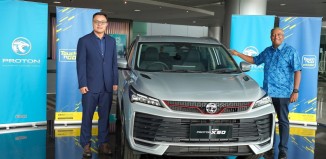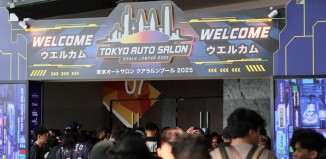aXcessaustralia One
The aXcessaustralia One car was also a unique model in that no recognised carmaker was involved at all. It wasn’t determined by any design goal but was instead an extraordinary commitment to design a car around products and services offered to the project by each participating company.
Millard Design Australia had to turn the conventional design process inside out while products and manufacturing services provided had to be from existing technology or technology available within three to five years.
Design work first started in the second half of 1996 based on major components such as the engine, transmission and driveline. There were literally hundreds of initial concept drawings with five shortlisted and developed into 30% scale models.
The body design of the prototype used an exoskeletal, external frame one-piece composite construction to support all the body panels and doors. Its hollow carbonfibre frame was produced from a plastic-faced synthetic gypsum mould that used a unique system of expandable mandrels. At just 69 kgs, the composite structure was bolted and bonded to the steel sub-frame that carries the engine, transmission and suspension components.
The car had an air quality sensor which could maintain acceptable air quality within the car. If the air was polluted, the ducting would be automatically switched to recirculating air until quality improved.
Put the car’s gear selector to ‘Park’ and the handbrake automatically engaged on all four wheels. The Banksia parkbrake, manufactured by PBR Automotive used 60% less components than conventional systems. It also had a lightweight single shoe design.
Venture Asia Pacific produced 2 mm thick carbonfibre body panels that mirror sheet metal in fit and strength. The one-piece panels were easily removed to expose internal workings.
The doors used an interlocking clam shell system by Millard Design Australia. Four single-hinged opened and closed sequentially through sophisticated electronic and optical controls. The doors – hinged at the rear – were operated by electric linear motors which require no manual force.
The engine in aXcessaustralia one was a supercharged 2.3 litre, 2-stroke in-line six manufactured by Orbital Engine Corporation. Its dry weight was 120 kgs, approximately 75% of the weight of a conventional 4-stroke ‘six’.
The car was equipped with an ‘EV-Alert’ system patented by Vehicle Early Warning Systems Pty. Ltd. The system activated an LED pulsing amber light and audible warning when the car approached within 300 metres of hazards such as emergency vehicles, rail crossings …even accident black spots.
The adjustable steering was a novel system designed and patented by Steering Systems Australia. It had a lightweight column that used a compound tilt mechanism known as a ‘compound tilt’ which allowed for infinite adjustments on every plane.
VDO Australia was responsible for a extremely slim instrument cluster that weighed less than one kg and was just 58 mm thick.
The lights came from Hella Australia with a ‘state-of-the-art’ slimline combination design. This incorporated a clear lens turn indicator, a projector type low beam and halogen high-beam spot light. The interior mounted, centre stop lamp had an innovative LED system with low current draw, low voltage drop and even light distribution.
The mirrors, both inside and out, were also innovative. Made by Britax Rainsfords, the exterior ones (only 700 gms each) contained a temperature sensor, turn signal lamp and the antenna for the passive entry system. The interior mirror had photo sensors in front and at the rear that enabled it to self-dull in intense light.
Bosch Australia designed a voice control system able to recognise 35-40 verbal commands that activated functions including gear selection, temperature control, CD and radio station selection, to start and stop the engine – even open and close doors!
The aXcessaustralia one car is still in existence but used more for display purposes to inspire industrial students to join the automotive industry.

























